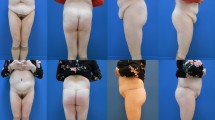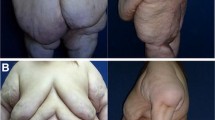Abstract
Introduction
Massive weight loss (MWL) patients present skin and soft-tissue laxity and ptosis involving inner thighs. Previous efforts were focused on the upper two thirds of the thigh, while literature has never dealt specifically with lower thigh contouring. We present an original approach to the lower inner thigh, intended for patients who already had upper thigh lift, discussing outcomes, advantages, and limits of our technique.
Materials and Methods
Sixteen female MWL patients with persisting severe deformities in the lower inner thigh, following an upper thigh lift, received lower third medial thigh contouring, through concurrent liposuction and skin excision, between 2017 and 2019. The excision pattern consisted of an inferiorly-based vertical triangular component, centered on the inner midline, and a distal horizontal crescent, resulting in an inverted-T scar. Our series was retrospectively investigated, comparing preoperative and 12-month postoperative pictures and assessing the outcomes by means of a tailor-made 11-item survey.
Results
Three patients had minor complications (two cases of skin de-epithelization at the wound margin, one granuloma). Photographic assessment showed a 15.9% transverse diameter reduction (p<0.05). The questionnaire showed encouraging scores for all the investigated items. Mean overall satisfaction was 9.6/10.
Conclusion
Despite the retrospective design and the limited sample size, in consideration of the applicability of this technique in selected cases, and the need for a two-step procedure, separate upper and lower thigh contouring, the results of our study showed a considerable improvement of the inner thighs by our personal combined liposuction and lower medial thigh lift approach.
Level of Evidence IV
This journal requires that authors assign a level of evidence to each article. For a full description of these Evidence-Based Medicine ratings, please refer to the Table of Contents or the online Instructions to Authors www.springer.com/00266.






Similar content being viewed by others
Change history
27 February 2024
A Correction to this paper has been published: https://doi.org/10.1007/s00266-024-03904-7
References
Livingston EH (2002) Obesity and its surgical management. Am J Surg 184(2):103–113
Song AY, Jean RD, Hurwitz DJ, Fernstrom MH, Scott JA, Rubin JP (2005) A classification of contour deformities after bariatric weight loss: the Pittsburgh Rating Scale. Plast Reconstr Surg 116(5):1535–1544 (discussion 1545–1546)
ASPS (2020) National plastic surgery statistics. Cosmetic surgical procedures. Arlington Heights: American Society of Plastic Surgeons. Available from: https://www.plasticsurgery.org/documents/News/Statistics/2020/plastic-surger. Accessed 5 Jun 2022
Mathes DW, Kenkel JM (2008) Current concepts in medial thighplasty. Clin Plast Surg 35(1):151–163
Kolker AR, Xipoleas GD (2011) The circumferential thigh lift and vertical extension circumferential thigh lift: maximizing aesthetics and safety in lower extremity contouring. Ann Plast Surg 66(5):452–456
Xie SM, Small K, Stark R, Constantine RS, Farkas JP, Kenkel JM (2017) Personal evolution in thighplasty techniques for patients following massive weight loss. Aesthet Surg J 37(10):1124–1135
Cram A, Aly A (2008) Thigh reduction in the massive weight loss patient. Clin Plast Surg 35(1):165–172
Michaels J (2019) Vertical medial thigh contouring. Clin Plast Surg 46(1):91–103
Simone P, Carusi C, Del Buono R, Persichetti P (2016) Medial thigh lift in post-bariatric patients: our encouraging experience. J Plast Surg Hand Surg 50(6):359–366
BAPRAS (2017) UK Commissioning guide: Massive weight loss body contouring. London: British Association of Plastic, Reconstructive and Aesthetic Surgeons, The Royal College of Surgeons of England. Available from: https://www.bapras.or. Accessed 5 Jun 2022
ASPS (2017) Patients, practice parameter for surgical treatment of skin redundancy for obese and massive weight loss. Arlington Heights: American Society of Plastic Surgeons. Available from: https://www.plasticsurgery.org/documents/H. Accessed 5 Jun 2022
Persichetti P, Simone P, Langella M, Marangi GF, Carusi C (2007) Digital photography in plastic surgery: how to achieve reasonable standardization outside a photographic studio. Aesth Plast Surg 31(2):194–200
Lewis JR Jr (1957) The thigh lift. J Int Coll Surg 27:330–334
Lockwood TE (1988) Fascial anchoring technique in medial thigh lifts. Plast Reconstr Surg 82:299–304
Lockwood T (1993) Lower body lift with superficial fascial system suspension. Plast Reconstr Surg 92:1112–1122
Le Louarn C, Pascal JF (2004) The concentric medial thigh lift. Aesth Plast Surg 28:20–23
Hurwitz D (2005) Medial thighplasty for operative strategies. Aesth Surg J 25:180–191
Bertheuil N, Huguier V, Beuzeboc M, Aillet S, Watier E (2013) Knee dermolipectomy: a simple operation with significant functional improvement. Aesth Plast Surg 1:117–120
Zeman-Kuhnert K, Gaggl AJ, Brandtner C, Wittig-Draenert AI, Bottini GB, Wittig J (2020) Donor site morbidity after microvascular medial femoral condylar flap procurement for facial reconstruction. Int J Oral Maxillofac Surg 49(5):569–575
Funding
No funding was received for this article
Author information
Authors and Affiliations
Corresponding author
Ethics declarations
Conflict of interest
No potential competing interest was reported by the authors. Authors have nothing to disclose
Ethical Approval
Requirements of the Declaration of Helsinki as well as principles of GCP were taken into consideration. Patients gave full consent to use their personal data. Local Research Ethics Committee did not require a formal ethical approval, as this surgery could have been formally considered the next step of the thigh deformity treatment.
Additional information
Publisher's Note
Springer Nature remains neutral with regard to jurisdictional claims in published maps and institutional affiliations
Rights and permissions
Springer Nature or its licensor (e.g. a society or other partner) holds exclusive rights to this article under a publishing agreement with the author(s) or other rightsholder(s); author self-archiving of the accepted manuscript version of this article is solely governed by the terms of such publishing agreement and applicable law.
About this article
Cite this article
Simone, P., Marchica, P., Savani, L. et al. An Original Approach to Massive Weight Loss Deformities in the Lower Thigh: A Retrospective Assessment of Results and Patients’ Satisfaction. Aesth Plast Surg 47, 1884–1893 (2023). https://doi.org/10.1007/s00266-023-03311-4
Received:
Accepted:
Published:
Issue Date:
DOI: https://doi.org/10.1007/s00266-023-03311-4




